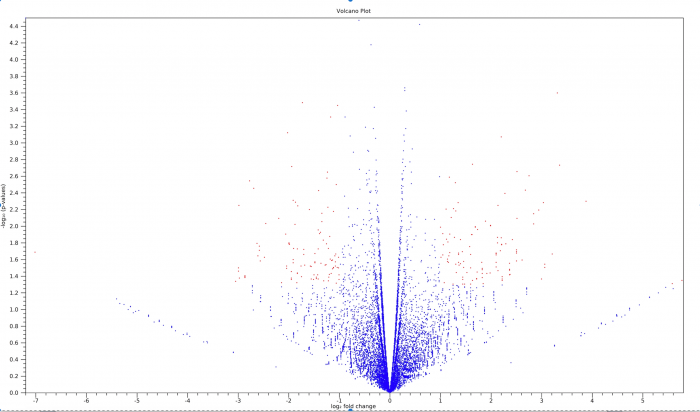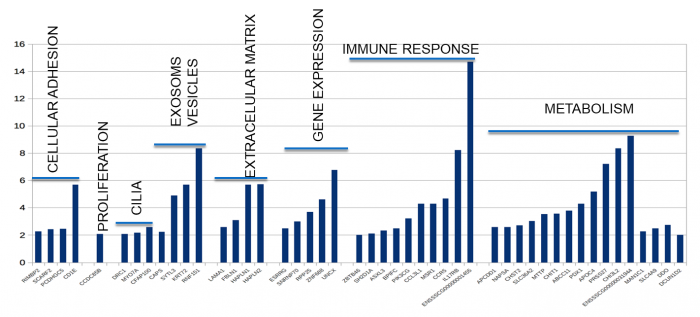Identification of genes and tissue-specific proteins induced by an intestinal conditioner

Effect of intestinal conditioner pronutrients on expression of genes related to intestinal mucosa status was evaluated on an in vitro culture of enterocytes.
Methodology
Procedure for obtaining specific tissue-proteins that have increased expression thanks to the use of intestinal conditioner pronutrients is based on the following stages:
1) Development of two cellular cultures of porcine enterocytes: one culture is a control (without treatment) and another culture is treated with an intestinal conditioner.
2) Isolation of total RNA from treated and untreated enterocytes.
3) Construction of a complete transcriptomic library and RNA sequencing.
4) Bioinformatic analysis: analysis of the differential expression between treated and untreated cultures, showed as volcano plot and heat map (Pictures 1 and 2).
5) Data review: search in databases about the biological function of differentially expressed genes, to determine molecular basis of the beneficial effect of an intestinal conditioner on enterocytes.

Picture 1. Volcano plot – Comparison between gene expression of control and treated cultures.
Volcano plot is a scatter diagram of -log10 (p) (on the vertical axis) as a function of M (on the horizontal axis). Genes that are expressed differently (statistically significant difference) and, therefore, with “fold change”, will tend to be found at the upper right and left sides of the chart.

Picture 2. Heat map – Comparison between gene expression of control and intestinal conditioner cultures.
In the case of the heat map, samples are grouped into control samples (right) and treated samples (left), and difference in expression is shown through a color code.
Results

Picture 3. Genes induced by the presence of an intestinal conditioner.
Treatment of porcine enterocytes in vitro with an intestinal conditioner increases the expression of certain genes related to:
- CELL to CELL ADHESION: Intensification of expression of genes involved in production of intercellular binding proteins, such as adhesins, cadherins and cell signalling proteins (involved in the reinforcement of tight junctions) that decrease paracellular permeability.
- MOBILITY OF MICROVILLI.
- EXHOSOMES AND VESICLES: Favor presentation of antigens.
- EXTRACELLULAR MATRIX: Overexpression of two genes involved in synthesis of hyaluronan, which is basic for intestinal homeostasis and leukocyte recruitment when infection occurs.
- IMMUNE RESPONSE: Enhanced expression of genes related to formation of receptors of cytokines and defensins of the BPI family.
- METABOLISM: Increased expression of genes involved in the synthesis of enzymes chitinases and glucosidases which collaborate in transport and metabolism of lipids and amino acids.
Conclusions
Intestinal conditioner pronutrients improve intestinal physiology, as it has been observed by the study of gene expression in an enterocytes culture:
- Increase absorption of nutrients and integrity of the mucosa (digestive barrier).
- Favor the renewal of epithelium, avoiding adhesion of pathogenic microorganisms to the mucosa.
All these facts are shown as greater use of nutrients of the diet and a decrease in appearance of diarrhoea, which means an improvement in general condition of the animal and productive parameters.
This intestinal conditioner has been developed by Biovet S.A. and it is marketed under the name Alquernat Nebsui.
